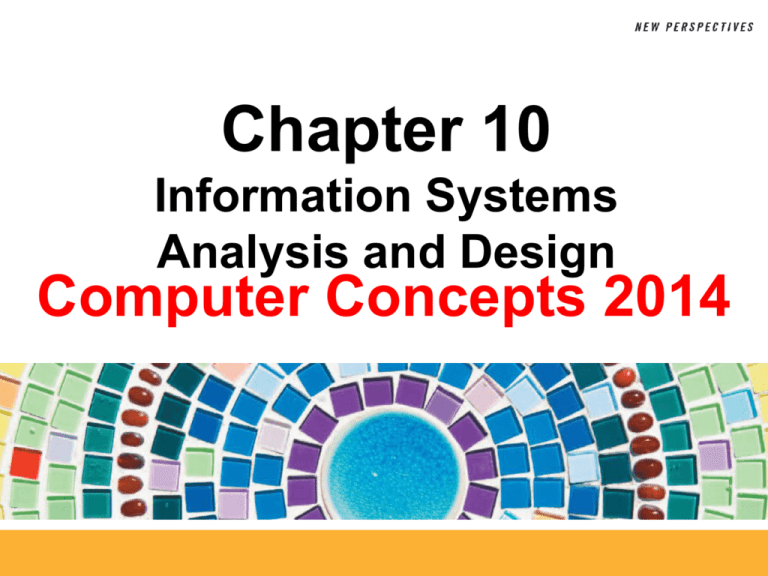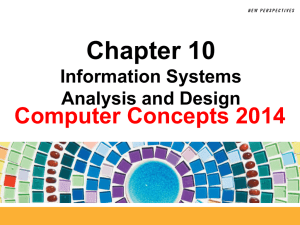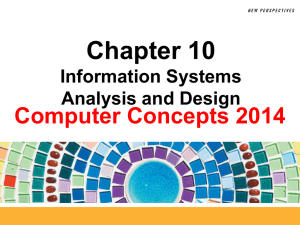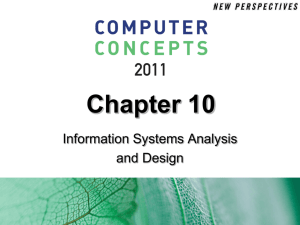NP2014_Chapter10 - Business and Computer Science
advertisement

Chapter 10 Information Systems Analysis and Design Computer Concepts 2014 10 Chapter Contents Section A: Information Systems Section B: Systems Analysis Section C: System Design Section D: Implementation and Maintenance Chapter 10: Information Systems Analysis and Design 2 10 Section A: Information Systems Information Systems in Organizations Transaction Processing Systems Management Information Systems Decision Support Systems Expert Systems and Neural Networks Chapter 10: Information Systems Analysis and Design 3 10 Information Systems in Organizations An information system collects, stores, and processes data to provide useful, accurate, and timely information An organization is a group of people working together to accomplish a goal Business Nonprofit organization Mission Mission statement Chapter 10: Information Systems Analysis and Design 4 10 Information Systems in Organizations Organizational charts depict the hierarchy of employees in an organization Chapter 10: Information Systems Analysis and Design 5 10 Information Systems in Organizations Information systems can: Automate routine tasks Make decisions in response to problems Structured problem Semi-structured problem Unstructured problem Collect and store internal or external information Chapter 10: Information Systems Analysis and Design 6 10 Transaction Processing Systems Provide a way to collect, process, store, display, modify, or cancel transactions Payroll, accounting, airline reservations, inventory, point of sale and cellular phone billing Batch processing vs. online processing OLTP system Commit or rollback strategy Detail reports Chapter 10: Information Systems Analysis and Design 7 10 Transaction Processing Systems Chapter 10: Information Systems Analysis and Design 8 10 Management Information Systems Chapter 10: Information Systems Analysis and Design 9 10 Management Information Systems Chapter 10: Information Systems Analysis and Design 10 10 Decision Support Systems Helps people make decisions by directly manipulating data, analyzing data from external sources, generating statistical projections, and creating data models of various scenarios Executive information system DSSs design decision models and make decision queries Chapter 10: Information Systems Analysis and Design 11 10 Decision Support Systems Chapter 10: Information Systems Analysis and Design 12 10 Expert Systems and Neural Networks Expert systems are designed to analyze data and produce a recommendation, diagnosis, or decision based on a set of facts and rules Knowledge base Inference engine Knowledge engineering Expert system shell Fuzzy logic Neural networks use computer circuitry to simulate how a brain may process info, learn, and remember Chapter 10: Information Systems Analysis and Design 13 10 Expert Systems and Neural Networks Chapter 10: Information Systems Analysis and Design 14 10 Section B: Systems Analysis System Development Life Cycle Planning Phase Analysis Phase Documentation Tools Chapter 10: Information Systems Analysis and Design 15 10 System Development Life Cycle Systems analysis and design is a discipline that focuses on developing information systems according to the phases of an SDLC Chapter 10: Information Systems Analysis and Design 16 10 Planning Phase Assemble the project team Justify the project Choose a development methodology Develop a project schedule Produce a Project Development Plan Chapter 10: Information Systems Analysis and Design 17 10 Planning Phase Justification for new system usually emerges from a serious problem with the current system, a threat to the organization’s success, or an opportunity to improve an organization’s products or services through technology Chapter 10: Information Systems Analysis and Design 18 10 Planning Phase An organization must be able to: Make improvements Change the industry Create new products The PIECES framework helps classify problems in an information system Chapter 10: Information Systems Analysis and Design 19 10 Planning Phase Development methodologies Structured methodology Information engineering methodology Object-oriented methodology PERT (Program Evaluation and Review Technique) WBS (Work Breakdown Structure) Gantt chart Chapter 10: Information Systems Analysis and Design 20 10 Planning Phase Chapter 10: Information Systems Analysis and Design 21 10 Analysis Phase Produce a list of requirements for a new or revised information system Analysis phase activities: Study the current system Determine system requirements Write System Requirements Report System requirements are the criteria for successfully solving problems identified in an information system Success factors Chapter 10: Information Systems Analysis and Design 22 10 Documentation Tools The core documentation tool for project teams using structured methodology is the data flow diagram (DFD) External entity Data store Process Data flow Chapter 10: Information Systems Analysis and Design 23 10 Documentation Tools Chapter 10: Information Systems Analysis and Design 24 10 Documentation Tools Current standard for object-oriented documentation is referred to as UML (Unified Modeling Language) A use case diagram documents the users of an information system and the functions they perform Actors A class diagram provides the name of each object, a list of each object’s attributes, a list of methods, and an indication of the cardinality between objects A sequence diagram depicts the detailed sequence of interactions that take place for a use case Chapter 10: Information Systems Analysis and Design 25 10 Documentation Tools Chapter 10: Information Systems Analysis and Design 26 10 Section C: System Design Design Phase Evaluation and Selection Application Specifications Chapter 10: Information Systems Analysis and Design 27 10 Design Phase The project team must figure out how the new system will fulfill the requirements specified in the System Requirements Report Chapter 10: Information Systems Analysis and Design 28 10 Design Phase The project team has to consider the overall architecture based on: Level of automation Processing methodology Centralized processing Distributed processing Network technology Chapter 10: Information Systems Analysis and Design 29 10 Design Phase Software alternatives Programming tools Application development tools Application software Turnkey systems Chapter 10: Information Systems Analysis and Design 30 10 Evaluation and Selection Decision support worksheet Chapter 10: Information Systems Analysis and Design 31 10 Evaluation and Selection A request for proposal (RFP) describes the information system problem and the requirements for the solution Chapter 10: Information Systems Analysis and Design 32 10 Evaluation and Selection A request for quotation (RFQ) is a request for a formal price quotation on a list of hardware and software Chapter 10: Information Systems Analysis and Design 33 10 Application Specifications Describe the way the information system’s software should interact with users, store data, process data, and format reports Feature creep refers to the failure to constrain change Changes should be managed formally, including written change requests Chapter 10: Information Systems Analysis and Design 34 10 Section D: Implementation and Maintenance Implementation Phase Development and Testing Documentation and Training Conversion and Cutover Maintenance Phase Chapter 10: Information Systems Analysis and Design 35 10 Implementation Phase Project team supervises the tasks necessary to construct the new information system Chapter 10: Information Systems Analysis and Design 36 10 Development and Testing Software customization is the process of modifying a commercial application to reflect an organization’s needs Application testing is performed in three ways: Unit testing Integration testing Test area System testing Chapter 10: Information Systems Analysis and Design 37 10 Development and Testing Chapter 10: Information Systems Analysis and Design 38 10 Documentation and Training System documentation Describes a system’s features, hardware architecture, and programming User documentation Describes how to interact with the system to accomplish specific tasks Procedure handbook Contains step-by-step instructions for performing specific tasks Chapter 10: Information Systems Analysis and Design 39 10 Conversion and Cutover System conversion Deactivating an old information system and activating a new one Several conversion strategies: Direct conversion Parallel conversion Phased conversion Pilot conversion Acceptance testing is designed to verify that the new information system works as required Chapter 10: Information Systems Analysis and Design 40 10 Maintenance Phase Involves day-to-day operation of the system, making modifications to improve performance, and correcting problems The term quality of service (QoS) refers to the level of performance a computer system provides Chapter 10: Information Systems Analysis and Design 41 10 Maintenance Phase The computer operator is responsible for operating the computer on a day-to-day basis The systems programmer installs new versions of the operating system and modifies settings to maximize performance The help desk is staffed by technical support specialists who are familiar with the information system’s software Chapter 10: Information Systems Analysis and Design 42 10 Maintenance Phase Maintenance phase costs Chapter 10: Information Systems Analysis and Design 43 Chapter 10 Complete Computer Concepts 2014











